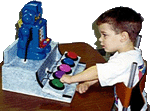|
Mystery Box
Mystery Box is an intriguing collection of 50 cards that
offers students fun practice using critical thinking strategies and oral
language skills. Each of the cards presents a mysterious situation that
needs to be solved; students try to decode the given information on each
card to find all possible meanings. Students solve the mysteries by
asking the teacher questions about the mystery to help them figure out
logical explanations.
This method encourages students to think beyond the obvious and to
listen very carefully to detail. These mystery cards are ideal for
spontaneous or planned language activities, and will encourage students
to think and reason in new and exciting ways. An Instruction Card is
included that explains Overview, Objectives, Teaching Suggestions,
Clues, Analogy, and Solutions.
Objectives
• Phrase questions to find unknown information
• Ask meaningful questions that can be answered "Yes" or "No"
• Use a variety of thinking strategies to unravel mysteries
• Sort through difficult and confusing information
• Persevere even when they feel frustrated
• Distinguish between meaningful and irrelevant information
The mystery cards are divided into three difficulty levels-10
Beginner, 25 Intermediate, and 15 Advanced. On the front of each
foldover card is a Mystery; inside the card are the Clues, Analogy
Clarification, and the Solution. Teachers read the Mystery out loud as
many times as needed. Students then begin asking questions in a search
to unravel the Mystery. There is no limit to the number of questions,
but they can only be answered by "Yes" or "No." Under certain
circumstances, the teacher is also permitted to answer "Not relevant" in
order to help the student.
There are three clues inside each Mystery card that should be used
only if students need extra help in solving the mystery. These clues can
come from more than 31 categories that assist students, such as Be
Realistic, Consider Alternatives, Explore All Possibilities, Focus on
Detail, Look at the Whole Picture, Break the Whole Into Parts, Beware of
Irrelevant Facts, and many more.
The final clue on the card is an Analogy. These provide an
opportunity for an extended educational experience since they offer a
unique way to analyze the situation. The Analogy Clarification on each
card also offer an opportunity to practice analogies in preparation for
standardized tests. A visual component can be added by putting the
comparison on the board in analogy format.
Below is an example of an Intermediate Level Mystery:
"The man died in a skiing accident. His death was caused by vandalism
that had taken place earlier in the evening. The vandal was known but
there was never a trial, and no charges of murder or manslaughter were
ever filed. Why was this vandal not prosecuted?"
Clues:
Consider Alternatives - Think of possible reasons why a known vandal
would not be prosecuted.
Work Backwards - Who was in the area at the time of the vandalism?
Analogy - The honey bee is his own worst enemy.
Solution:
The man who had died had vandalized the ski resort by removing
protective coverings from a steel tower. He then crashed into the tower
on his next run down the slope. Since the vandal was dead, no charges
were filed.
|





